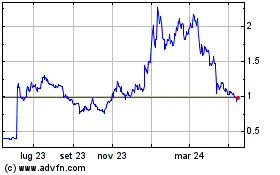Ethereum Solo Staking Made Easier? Vitalik Buterin Supports Lower Entry Requirements
04 Ottobre 2024 - 7:00AM
NEWSBTC
Ethereum (ETH) co-founder Vitalik Buterin advocates reducing the
ETH solo staking requirement to lower the entry barrier and promote
greater network decentralization. Buterin Sees 32 ETH Requirement
As A Barrier Responding to Ethereum educator Anthony Sassano on X
regarding solo staking, Buterin expressed concern that the current
32 ETH requirement presents a bigger obstacle than bandwidth
limitations. Related Reading: Vitalik Buterin Proposes A Privacy
Fix for Ethereum For those unfamiliar, solo staking on Ethereum
requires an individual validator to stake at least 32 ETH –
approximately $75,200 at the current market price of $2,352. Solo
staking allows crypto investors to earn passive income while
directly contributing to the security of the Ethereum network.
Buterin views this high entry threshold as a barrier that prevents
smaller ETH holders from participating. He suggested temporarily
increasing bandwidth requirements to reduce the minimum staking
deposit to 16 or 24 ETH. Buterin elaborated: It’s net-good for both
staking accessibility and scale. Then once we figure out peerdas,
bandwidth reqs go back down, and once we figure out orbit SSF, the
deposit minimum can drop to 1 ETH. It’s important to note that ETH
holders can still stake with as little as 1 ETH by using
third-party staking services, centralized platforms, or staking
pools. However, these options don’t offer the same level of control
over one’s ETH as solo staking, where the node operator retains
full custody of their holdings. During the Ethereum Singapore 2024
event in September, Buterin emphasized the significance of solo
stakers in bolstering Ethereum’s security and decentralization to
tackle potential 51% attacks. At the event, Buterin said that even
a small increase in the proportion of solo stakers on the Ethereum
network could work as an “extra layer of defense” for both security
and privacy. Ethereum Layer-2 Solutions Continue To Thrive While
the 32 ETH barrier may discourage small-scale ETH enthusiasts from
solo staking, they can still benefit from the growing popularity of
Ethereum layer-2 solutions, which have made transactions more
affordable. For instance, in June 2024, layer-2 scaling platform
Optimism announced the launch of open-source and permissionless
fault proofs, enabling users to verify off-chain transactions’
validity securely. Similarly, in August 2024, asset manager
Franklin Templeton approved another layer-2 solution when it
launched its OnChain US Government Money Fund (FOBXX) on the
Arbitrum network. Related Reading: Ethereum Layer 2 Networks Just
Set A New Record Similarly, crypto exchange Coinbase’s Ethereum
layer-2 rollup Base has witnessed rapid adoption as its total value
locked (TVL) currently stands at slightly over $2.12 billion,
according to data from DeFiLlama. As layer-2 solutions continue to
succeed, their positive impact may extend to the Ethereum network.
Crypto analysts, such as CryptoBullet, predict that ETH could rally
in Q4 2024. ETH is trading at $2,352 at press time, down 3.5% in
the past 24 hours. Featured image from Unsplash, chart from
Tradingview.com
Grafico Azioni Arbitrum (COIN:ARBUSD)
Storico
Da Mar 2025 a Mar 2025

Grafico Azioni Arbitrum (COIN:ARBUSD)
Storico
Da Mar 2024 a Mar 2025
